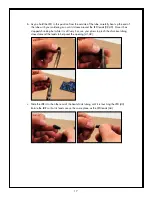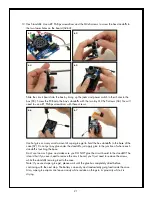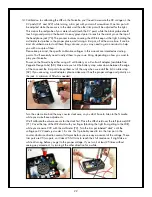
28
PLAYING YOUR NOISETTE
Apply power to your Noisette either by attaching a 9 volt battery to the battery snap or by using a 9
volt (center negative) power adapter (the same type of power supply a typical guitar pedal uses).
If you want to use the internal speaker, move the jumper on the internal circuit board header to
the SPEAKER position. If you want to use the headphones or line out jack, move the jumper to the
HEADPHONES position. Be careful not to use the headphone output while the jumper is in the
SPEAKER position because the signal will be very loud and could damage your ears, and possibly
your headphones!
The Noisette uses two light sensors to control pitch (right side sensor) and volume level (left side
sensor). You can partially cover these sensors with your fingers or hands to alter these parameters.
The more light the sensors detect will cause the theremin to produce a higher frequency and louder
volume output. The less light the sensors detect will cause the theremin to produce a lower frequency
and quieter volume output, to the point of turning off the sound entirely, and perhaps creating lower
frequencies than your speaker or headphones can reproduce. Please note, the ambient light level
around the theremin will have a significant role in the sensor’s dynamic range, meaning the brighter
the environment is, the louder the theremin can get, and the higher frequencies it can make. The set
calibration points have a lot to do with how the Noisette responds to relative light levels. Please feel
free to experiment in environments with different types of lighting and different calibration points (see
page 22 for calibration information). It’s also fun to experiment with flashlights or other light sources.
Most importantly, be creative and have fun with your Noisette!



































